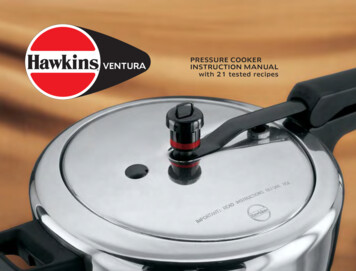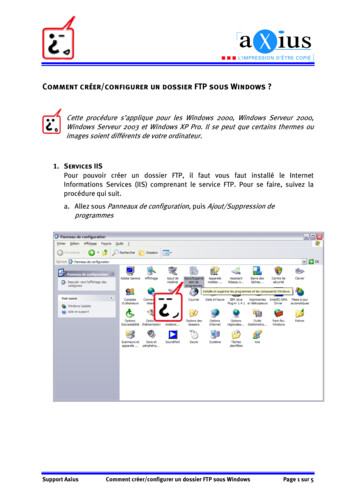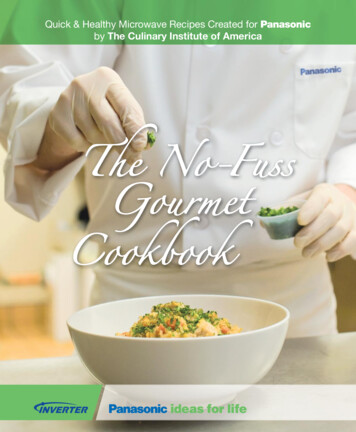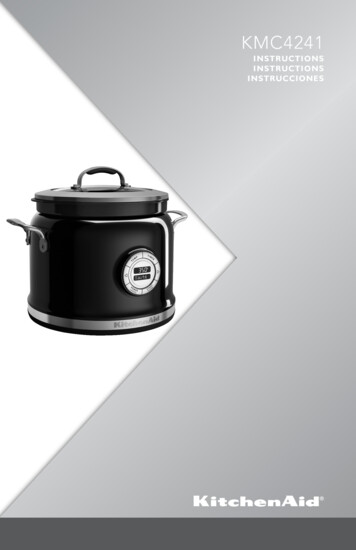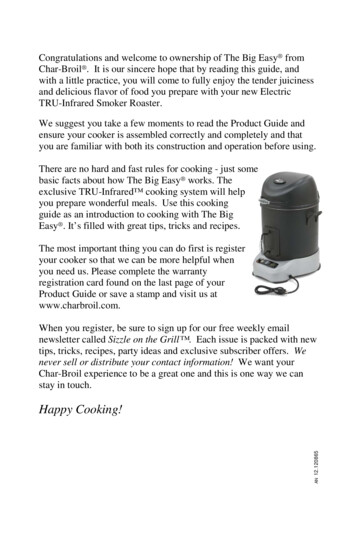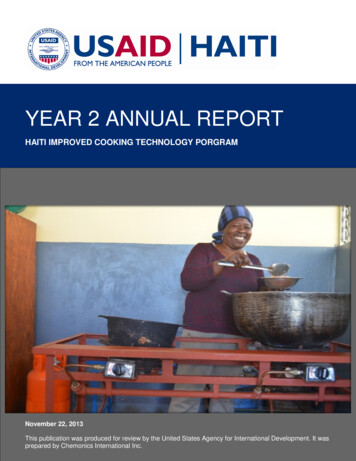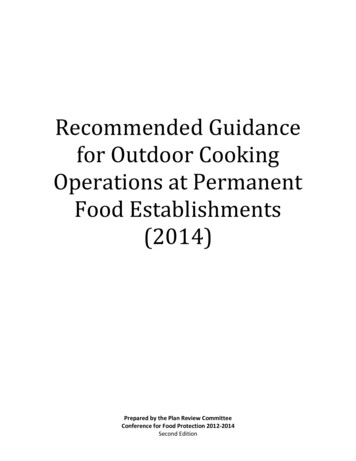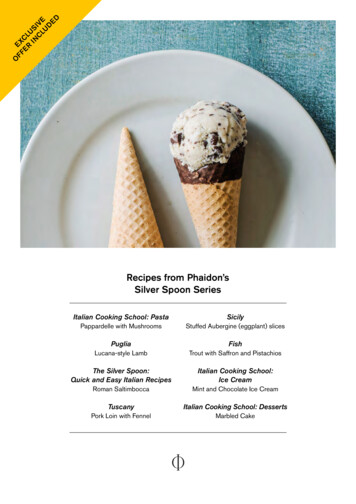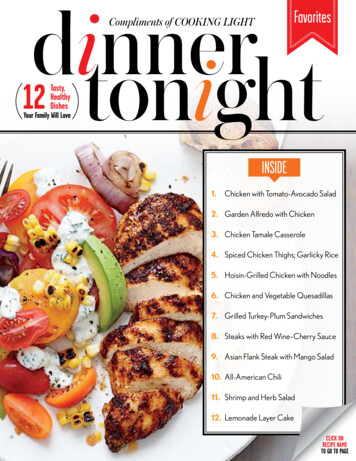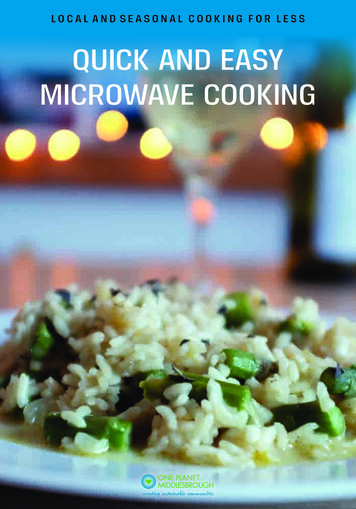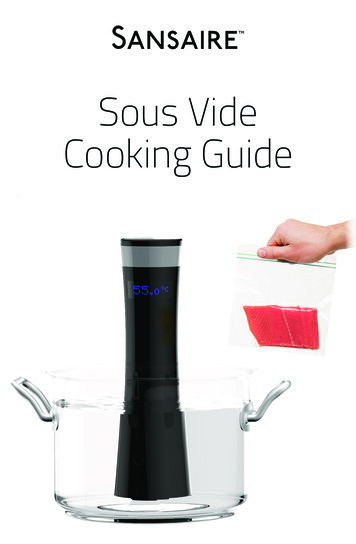
Transcription
Sous VideCooking Guide
What is sous vide?Sous vide is a cooking method that uses precise temperaturecontrol to achieve perfect, repeatable results that you just can’treplicate through any other method. Foods are cooked evenlyfrom edge to edge, to exactly the doneness you want. Andbecause foods won’t overcook while they hang out in the waterbath, dinner is ready when you are. The world’s best chefs relyon sous vide, and now you can too.Cooked Sous Videwith the SansaireCookedTraditionallyWhy cook sous vide?FOODIESThe Sansaire is used in some of the world’s best restaurants. Professional chefsrely on sous vide for precise, predictable results. Now you can too!HEALTHY EATERSVegetables retain all of their nutrients because the bag is sealed—there’s nowherefor nutrients to escape! Also, cooking foods in a sealed environment allows you tocoat proteins and vegetables with a fraction of the amount of oil or butter.FAMILIESEnjoy the same lifestyle benefits of slow-cooker cooking but without dried-out,overcooked proteins.HOLIDAY HOSTSNo more dried-out turkey, overcooked prime rib, tough brisket, or lamb. Yourproteins will always be perfectly juicy, even if the football game goes into overtimeor your guests arrive late.BBQ & GRILLING ENTHUSIASTSSmoke for flavor, cook with the Sansaire for texture. The most succulent barbecueon the planet is cooked sous vide.NEW MOTHERSHeat milk or formula to precisely 98.6 F for worry-free feeding.APARTMENT DWELLERSMake whole meals in the Sansaire with no cookware to clean afterward.The foods in each row were heated to the same internal temperature.12
Sealing your foodVacuum sealers aren’t required for most foods cooked withthe Sansaire. Vegetables, fish, poultry, and other proteins thatcook for less than eight hours can be sealed using zip-top bagsand the water displacement method. We recommend usingname-brand bags made of polyethylene or polypropylene(the material is listed in small print on the box). Always use bagslabeled as BPA-free, and that do not contain PVCs. Due totheir sturdier construction, freezer bags are a great choice.Setting up your Sansaire1Place your food in a zip-top bag.2Add a small amount of neutraltasting oil to the bag to help fillin air gaps.3While holding the top of thebag open, slowly lower it into acontainer of water. The pressureof the water will squeeze the airout of the bag.4Just before the top of the bagreaches the water, zip it closed.1. Pick a container large enough to hold your food, and with plenty of room forwater to circulate. We recommend a polycarbonate food storage container, ora large metal pot. Avoid plastic containers made with BPAs or PVC materials.2. Attach the Sansaire to the side of the container using the clamp. Add wateruntil the level is above the Minimum Fill line on the Sansaire, but below theMaximum Fill line. Remember that the water level will rise when you add yourfood.3. Plug in the Sansaire.4. Press the power button on the top of the unit. This turns on the display andmakes the circulator heat the water to the set target temperature. Set thetarget temperature of the water bath by turning the silver temperature ringabove the display. The Sansaire automatically keeps the water at the targettemperature until you turn it off. Your water bath is now ready for cooking!3For cooking times longer than eight hours, werecommend sealing foods with a vacuum sealer.4
How to cook eggs sous videCooking eggs sous vide is a rite of passage for every owner of the Sansaire.Whereas perfectly poaching an egg is a difficult and noteworthy achievement intraditional cooking, you can perfectly poach a dozen eggs sous vide with your eyesclosed. By allowing the eggs to cook slowly over 45 minutes, their texture willbecome fudgy and silken. You’re about to upgrade your brunch game.TIME TO COMPLETETHINGS YOU’LL NEED45 minutes (5 minutes hands-on)Just your Sansaire34SET UP YOUR SANSAIRE (see page 3)Pick a container that will be large enough to fit the number of eggs youwant to cook, with extra room left over for water to circulate. A small potis a great choice.2COOK FOR 45 MINUTESYour eggs will be ready in 45 minutes, so you’ve got some time to finishSunday's crossword puzzle. Here’s a hint: eight letters, a two-word phrasefor the perfect wayto cook eggs.51ADD EGGS TO THE WATER BATHNature was kind enough to seal eggs inside their own sous vide packaging(the shell!) so it’s not necessary to use bags when cooking whole eggs.Because the water will be hot, and because we don’t want the eggs to crack,lower them gently into the water bath using a spoon.REMOVE, RINSE & SERVEUsing tongs or a slotted spoon, remove the eggs from the bath. Run theshells under cold water for a few seconds until they’re cool enough to handle.Crack the shells gently and decant perfectly cooked sous vide eggs onto thedish of your choice.PICK YOUR PERFECT EGGThis is entirely a matter of personal preference. Do you like your eggs runnyand soft, or thick and spreadable? Pick your doneness and set your Sansaireto the listed temperature.Runny62 C / 143.6 FMedium Poached68 C / 154.4 F5Just Set65.5 C / 149.9 FSoft-Boiled73 C / 163.4 F Now that you’ve violated the laws of physics by producingsuch an amazing egg, it’s time to share with others. Post yourresults to the interwebs with hashtag #sansaire, and we’llbrag on your behalf.6
How to cook steak sous videThis is going to be a little different than the way you’ve cooked steaks in thepast, but you’re going to love the results. Achieving the right doneness (rare,medium-rare, medium, and so on) doesn’t require expert timing or x-ray vision.All you have to do is choose the temperature you prefer.TIME TO COMPLETEPick a container that will be large enough to fit your food, with extra roomleft over for water to circulate. A large soup pot is a great choice.24PREHEAT A SKILLETJust before you’re ready to eat, preheat a heavy-bottomed skillet (we lovecast-iron) until it is rocket hot.5REMOVE YOUR STEAKUsing tongs, remove your bags of steak from the bath, remove the steaksfrom their bags, and pat them dry.6SET UP YOUR SANSAIRE (see page 3)SEAL YOUR STEAK & COOK FOR 1 HOUR (see page 4)Your steak will be ready for the next step in an hour. So put your feet up andrest for a while! If that hour of indulgent time turns into two or three or fourhours, no worries. Your steak will still be just as perfectly cooked when youreturn to it.THINGS YOU’LL NEED1 hour (15 minutes hands-on)Your SansaireZip-top bagSkillet13SEAR & SERVEAdd your steaks to the rocket-hot skillet and check them after 30–60seconds. When you see a golden crust that meets your standards, flip andrepeat on the other side. Then plate, serve, and prepare for a hero’s welcome.HOW DO YOU LIKE YOUR STEAK?Take your time this could be the most important decision you’ll make today.Pick your doneness and set your Sansaire to the listed temperature.Rare50 C / 122 FMedium56 C / 132.8 F7Medium-Rare54 C / 129.2 FWell-Done60 C / 140 F If this was the best steak you’ve ever cooked, we want tohear about it. Scratch that, we want to see it! Post yourresults to the interwebs with hashtag #sansaire, and we’llbrag on your behalf.8
How to cook fish sous videYou’re about to cook the best fish you’ve ever eaten. We use salmon in thisrecipe, but feel free to substitute with whatever is available in your area. It will beindescribably moist and tender in a way that traditional cooking can’t replicate.Because fish is so delicate, small differences in cooking temperature have a bigimpact on the final texture. Good thing we leave nothing to chance.TIME TO COMPLETE34THINGS YOU’LL NEED5SET UP YOUR SANSAIRE (see page 3)(see page 4)REMOVE YOUR FISHUsing tongs, remove your bags of fish from the bath. Handle them gently,as they’re pretty delicate. You can turn off the Sansaire now, or keep itrunning as a Zen water feature in your kitchen.30 minutes (15 minutes hands-on)Your SansaireZip-top bag1SEAL YOUR FISH & COOK FOR 30 MINUTES.Your fish will be ready in 30 minutes (see the back cover for cooking times forcuts thicker than a half inch). Nobody has to know that you fell asleep whilecooking dinner. If you’re a multitasker, this is also a great time to make yourside dishes and sauces. Or, if you really want, you’re more than welcome tostare at the fish for half an hour. It’s your call.SEASON & SERVEGrab a pinch of flaky salt and some olive oil. Or reach for your favoriteseasoning. Now’s the time to get creative and shout “Bam!” Plate,serve, and prepare to share and enjoy. Bravo!Pick a container that will be large enough to fit your food, with extra roomleft over for water to circulate. A large soup pot is a great choice.2PICK THE DONENESS YOU PREFERThat’s right, you get to choose how you want your fish cooked.Pick your doneness and set your Sansaire to the listed temperature.Very Lightly Cooked45 C / 113 FLightly Cooked50 C / 122 FMedium55 C / 131 F9 Did you love it? We hoped you would. Now it’s time to showoff. Post your results to the interwebs with hashtag #sansaire,and we’ll brag on your behalf. Anything this awesome deservesto be shared.10
How to cook poultry sous videForget the dried out, bland chicken you may have endured in the past. With theSansaire, poultry remains juicy, succulent, and so flavorful that all you need is apinch of salt to make it shine. Pro tip: cook your dark meat first, then lower thetemperature and add your white meat to the same bath.TIME TO COMPLETESET UP YOUR SANSAIRE (see page 3)Pick a container that will be large enough to fit your food, with extra roomleft over for water to circulate. A large soup pot is a great choice.2SEASON & SEAL YOUR POULTRY (see page 4)If you like, now’s a great time to add some flavor to the bag. Your favoritehot sauce, teriyaki sauce or barbeque rub will season the meat as it cooks.4COOK UNTIL YOU’RE READY TO EATRelax, unwind, and look forward to the incredible meal ahead. As yourchicken cooks, it becomes more and more tender. After eight hours in thebath, your poultry will be as delicate as the best confit.THINGS YOU’LL NEED1:30 hour (10 minutes hands-on)Your SansaireZip-top bag135SHRED OR SEAR & SERVEWant to shred your poultry for tacos or salads? Rinse the bag under coolwater, then squish the sides of the bag between your fingers and watchhow effortlessly the meat shreds!Or if you prefer to keep things intact, pat your pieces dry and give them aquick sear on the stove, under the broiler, or in the deep fryer before serving.WHITE MEAT OR DARK?To maximize the juiciness of each part of the bird, we prefer to cook ourwhite meat and dark meat at different temperatures. Skin-on or skinless,bone-in or boneless, the times and temperatures depend only on thethickness of the meat. Times given here are based on one-inch thick piecesof chicken.11White Meat62 C / 144 FDark Meat65 C / 149 FCook for 1:30 hrs(including 30 minutes to pasteurize)Cook for 1:30 hrs(including 30 minutes to pasteurize) If this chicken changed your perception of poultry, you’renot alone. Post your results to the interwebs with hashtag#sansaire, and we’ll brag on your behalf.12
How to cook vegetables sous videCooking vegetables sous vide has a number of advantages to the traditionalmethods of steaming or boiling. Because the vegetables cook in a sealed bag, theyretain all of their nutrients and, more importantly, all of their flavor. The naturalsugars in vegetables are water-soluble, and in a boiling or steaming pot, thesesugars will be whisked away into the surrounding water, leaving your vegetablesdull and bland. When cooked sous vide, however, those flavors stay where theybelong. And, as you’d expect, there’s no guesswork or fork probing required to knowwhen your vegetables are properly cooked.Unlike meats, which typically cook between 50 C / 122 F and 65 C / 149 F,vegetables require much higher heat to soften. With a few specific exceptions,like corn and zucchini, most vegetables soften at temperatures between80 C / 176 F and 88 C / 190 F. As with proteins, the minimum cookingtime depends on thickness.COOKING TEMPERATURESCOOKING TIMESVegetable C ion85185Potatoes, cubed85185Squash**85185Turnips85185* kernels or whole cob, only 15 of minutes cooking time required** butternut, acorn, delicata, spaghettiTemperatures adapted from Modernist Cuisine, Vol. 3, Chapter 1213Sous vide asparagus with 65 C egg and pancettaIngredient65 C sous vide eggs (make ahead)Asparagus, trimmedUnsalted butter, cubedVolumeWeight2 eggs110 g1 bunch250 g1 Tbsp15 gPancetta, cubed½ cup113 gHollandaise sauce (make ahead, or store-bought)¼ cup24 g15minsLemon zest1 tsp1gCayenne pepper¼ tsp1g30minsFlaky sea salt1 :00to taste1. Prepare the 65 C egg following the instructions in our Sous Vide Egg guide.Set aside the eggs (still in their shells) in a bowl of hot tap water to keep warmuntil serving, up to 1 hour.2. Preheat your water bath to 85 C / 185 F.3. Using the size of your vacuum sealing or zip-top bag as your guide, cut theasparagus to length.4. Combine the asparagus and butter in a vacuum sealing bag and seal, ensuringthat the asparagus forms a single layer.5. Cook for 15 minutes.1:456. Meanwhile, fry the pancetta until crispy.7. To serve, carefully remove the asparagus from the vacuum sealing bag onto awarmed platter. Crack the sous vide eggs, and place them on the asparagus. Topwith hollandaise sauce, lemon zest, cayenne pepper, and salt, to taste.14
Frequently asked questionsQ Is sous vide cooking just for fancy chefs?Food safetyCooking sous vide is just as safe as traditional cooking methods. Some peoplesee the relatively low cooking temperatures used in sous vide cooking and worrythat this will make their food unsafe to eat. Luckily, that’s not the case. Althoughhigher cooking temperatures will pasteurize your food more quickly, those hightemperatures also make your food dry and unappetizing.Not all food needs to be pasteurized in order to be considered safe to eat. Theinterior of a steak or other intact animal muscle, for example, is considered a sterileenvironment: if there were pathogens inside the meat, the animal would haveappeared sick. However, we do want to destroy any pathogens that may havegotten onto the surface of the meat. Searing after cooking sous vide takes careof this risk, and adds a delicious crust!Poultry is no different than other meats. To reduce the risk of illness due tosurface contamination, we include additional cooking time in all of our poultryrecommendations to ensure pasteurization, so searing your poultry is optional.Fish pose a different set of food-safety considerations. The times andtemperatures that we recommend for fish create the best-tasting results, but donot necessarily ensure pasteurization.As with any lightly cooked food, there is always some risk of foodborne illness,and the amount of risk you’re willing to accept is a personal choice. Although foodsafety is a complex and nuanced topic, the best way to keep your risks as low aspossible is to follow good sourcing and safe handling practices.A Not at all! Cooking sous vide is easy and practical for home cooks of all levels.The Sansaire cooks foods evenly from edge to edge, to exactly the donenessyou want. And because foods won’t overcook while they hang out in the waterbath, dinner is ready when you are. Whether you’re preparing a multicoursedinner party or cooking a weeknight meal, cooking sous vide alleviates thestressful, split-second timing required by traditional cooking.Q Is sous vide the same as “boil-in-a-bag”?A If you’ve endured the dry, bland horror of boiled meat, we can understandwhy the idea of cooking food in sealed bags may induce a knee-jerk reaction.The key difference is that sous vide cooking uses much lower temperatures tocook your food—temperatures that are precisely chosen to produce the juiciest,most flavorful results. As meat gets hotter, the muscle fibers begin to contract,causing the meat to plump and firm slightly. If the meat gets too hot—as in theboiling scenario, the muscle contraction actually squeezes the juices out of themeat, leaving you with a tough, tasteless mess. Sous vide cooking temperaturesare well below this threshold, ensuring that your proteins are always properlycooked.Q Is it safe to cook in plastic bags?A Bags made of polyethylene and polypropylene that are labeled BPA-free areperfectly safe for sous vide cooking. Polyethylene and polypropylene havebeen used in laboratory settings for decades, and if they leached any chemicals,those chemicals would have thrown off the results of sensitive experiments.Always avoid bags containing polyvinyl chloride (PVCs) or those not labeled asBPA-free. Most name-brand zip-top bags, as well as the bags sold for vacuumsealing, will list their ingredients on the box.Consuming raw or undercooked meats, poultry, seafood, shellfish,eggs, or unpasteurized milk may increase your risk of foodborne illness.Further Reading: Modernist Cuisine Vol 1. Chapter 31516
REMOVING BACKCOVER & GRATEUSER INTERFACEDuring regular operation, the primary user interface is the power button to turn themachine on and off and the temperature ring to change the target temperature.The display, by default, shows the current temperature of the water. However,when the temperature ring is turned or the power is turned on, the display turnsto showing the target temperature. Typical temperatures range from 40 C /104 Fto 85 C / 185 F. To view the target temperature at any point, press the targettemperature button.The circulator has a back cover thatdetaches for cleaning. It should only bedetached when the circulator is off andunplugged;it should never be detached during use.To open: Detach the clamp, slide thelatch left, and pull the back cover downand away. With the cover off, the gratecan be detached as well.The display can be set to show temperature in Celsius or Fahrenheit by pressingthe C/F button.To close: Place the grate in the slot running along the bottom of the circulator’sfront, inner surface. The two grooves on the grate should be aligned toward the leftand right side of the casing. The back cover can now be slid back on and latched,followed by the attachment of the clamp.CLEANINGDECALCIFYINGIn the course of normal use, food particles and minerals from the water bath maycollect on the Sansaire immersion circulator. We recommend regular cleaning ofthe housing, impeller, and heating coils.After some time, the water from the bath deposits calcium on the coils. Whenthe coils become covered by calcium deposits, they need to be cleaned. Adda decalcifying agent, such as CLR, to your water bath, following the dilutioninstructions provided by the manufacturer. Set the temperature of your waterbath to 25 C / 77 F and allow the unit to run for 10 minutes. Power off, unplug,and remove the Sansaire from the water bath and continue cleaning per theinstructions above. Discard the water in the bath, and thoroughly clean thecontainer and any other materials in contact with the bath.1. Power off, unplug, and remove the Sansaire from the water bath. If the unit ishot, wait for the unit to cool down.2. Remove the power cord from the back of the unit.3. Remove the clamp from the back of the unit.4. Slide the back cover tab to release the back cover, exposing the impeller andheating coils. NOTE: The upper section of the Sansaire contains sensitiveelectronics and should never come in contact with water.5. While holding the unit upright, rinse under running water to remove foodparticles and cool the coils if still warm.6. If necessary, scrub the unit gently with a sponge or brush and a drop of dishwashing liquid. Rinse the unit thoroughly, ensuring that water does not enterthe upper section.7. Reinstall the back cover and clamp.17WARNING: Do not add food (bagged or otherwise) to the water bath while cleaning,and ensure that the bath water has been replaced with fresh water before cooking.STORAGEYou may choose to leave the Sansaire clamped to the water bath when not in use,but it should be unplugged from the power source. However, should you need tostore your circulator, wipe the unit dry using a cloth or paper towel prior to puttingit away.18
Sous Vide Quick ReferencePROTEINTEMPTender Beef52 C126 FTo core temperaturePoultry (White Meat)62 C144 FTo core temperature 30 mins to pasteurizePoultry (Dark Meat)65 C149 FTo core temperature 30 mins to pasteurizeFish50 C122 FTo core temperaturePork65 C149 F36 hrsTough Cuts62 C144 F72 hrsFilet, Strip Steak, Rib Eye, T-BoneChicken, Turkey, DuckChicken, Turkey, DuckSalmon, Tuna, Cod, Snapper, TilapiaShoulder, BellyShort Ribs, Brisket3"6 hr4:15 hr2"3 hrTIME1 hr for a 1"-thick steak1:30 for a 1"-thick chicken breast1:30 for a 1"-thick chicken leg30 minutes for a ½"-thick filletfor a braised texturefor a braised textureFOOD THICKNESS & COOKING TIME6 hrUse the guides at the edge of the page to determine howlong it takes for the core temperature of your food—thetemperature inside the middle of the food—to reach thedoneness temperature in the table above.Some foods, like poultry, require additional cooking time topasteurize. Other foods, like tough cuts of meat, are bestwhen cooked for much longer amounts of time, to achievea braised texture.7 cm6 cm3 hr1 hr5 cm4 cm1.5 hr1"8 cmsansaire.com3 cm1 hr2 cm30 minsFollow us @sansaire / Designed in Seattle, WAConsuming raw or undercooked meats, poultry, seafood, or shellfishmay increase your risk of foodborne illness. Temperatures adapted from Modernist Cuisine.25 mins1 cm
Cooking eggs sous vide is a rite of passage for every owner of the Sansaire. Whereas perfectly poaching an egg is a difficult and noteworthy achievement in traditional cooking, you can perfectly poach a dozen eggs sous vide with your eyes closed. By allowing the eggs to cook slowly ove
